Planting cherries in the fall in open ground
Perhaps every summer resident wants to have a cherry orchard or at least one cherry tree on his site. You must understand that you are no exception, since you have entered this material.
Well, our article will help you to carry out the correct autumn planting of cherry seedlings.
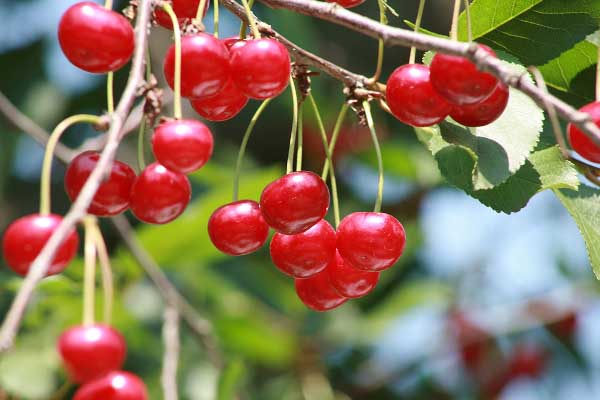
Content
When to plant cherries in the fall, in what month: optimal timing
To determine the right timing for the autumn planting of cherry seedlings, you need to calculate when they will come to your region resistant frost, and land 3-4 weeks before them.
The point is that the seedlings should have time to take root well before the onset of cold weather and successfully prepare for winter, and this will take time.
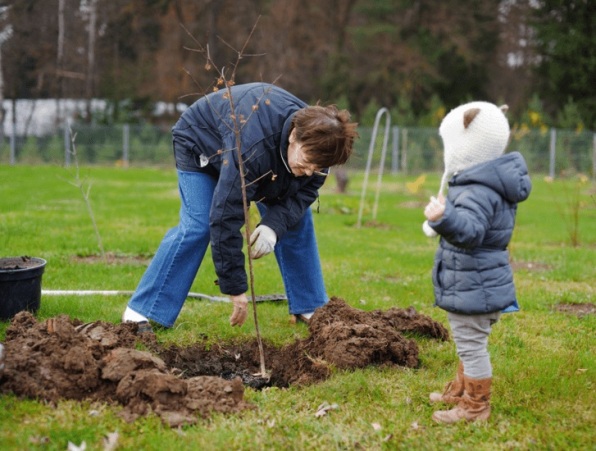
However! There is an old rule: pome crops (apple and pear) can be planted in the fall, and stone fruits (cherries, cherries, plums, apricots) - better only in the spring... This is explained by the fact that stone fruits are more thermophilic and less frost resistant than pome fruits.Some people even believe that in the southern (warm) regions it is better to plant all crops in the fall, and in the northern (cold) regions only in the spring.
Advice! The best time to plant seedlings is cloudy and calm weather, early morning or late evening.
Planting dates in the fall in the regions
Thus, the approximate (tentative) dates for autumn planting of cherries in the regions are as follows:
- In southern Russia, cherries can be planted until late autumn - until the end of November.
- In the Middle Polos (Moscow region), the autumn planting of cherries should be done before the end of October.
- In colder regions - in the North-West (in the Leningrad region), as well as in Siberia and the Urals, cherry trees are planted in autumn in early autumn - in September.

According to the lunar calendar for 2020
Choosing the optimal date for planting seedlings can help you moon calendar.
So, favorable days for planting cherries in the fall in 2020, according to the lunar calendar, are:
- in September - 19-26;
- in October - 3-13, 18-21.
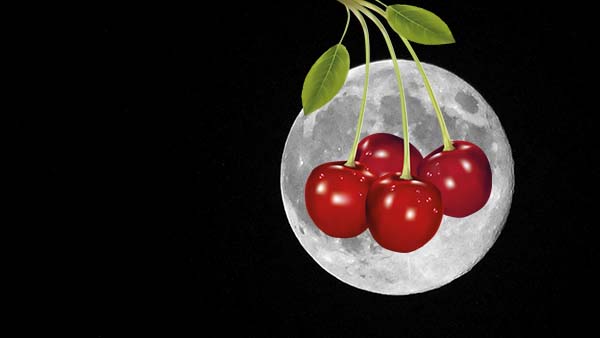
Of course, it is not always possible to get to the dacha on favorable days, so the main thing is not to land on unfavorable dates (the days of the Full Moon and New Moon, as well as the period when the Moon is in Aquarius, since this is a barren and dry sign -italicized).
Unfavorable days, according to the lunar calendar for 2020, for the autumn planting of cherry seedlings, the following dates are:
- in August -3, 4-5, 19, 31;
- in September -1, 2, 17, 27-28.
- in October - 2, 16,24-26, 31
- in November - 15,20-22, 30.
According to the lunar calendar, from the magazine "1000 Tips for Summer Residents".
How to plant cherries in the fall - step by step instructions
Next, you will receive a step-by-step guide that will help you properly prepare and plant a cherry seedling according to all the rules.
How to choose a seedling and prepare it for planting
When choosing a cherry seedling, you need to pay attention to the following:
- The variety must be zoned, well-proven in your climatic growing conditions, have a sufficient level of winter hardiness for your area.
- 1-2 years of age (not older).
- Have a healthy appearance, fully ripe shoots (wood should be brown, not green), a well-developed root system.
- The bottom of the barrel should be clearly visible vaccination site (connections of rootstock and scion), which will guarantee that this is a varietal tree, and not wild (seedling).
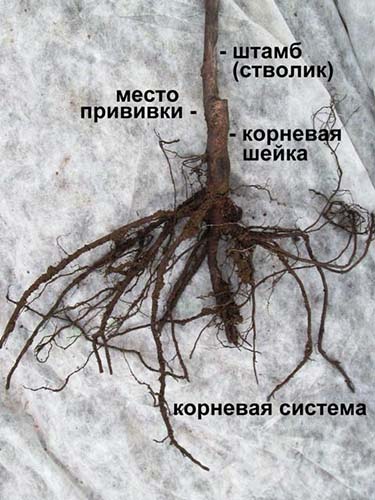
As a rule, the vaccination is done by budding method (they also say "grafted with an eye"), less often with a handle (ie copulation).
Preparing for landing
Immediately before planting, the roots of the seedling should be washed from the old soil, then dipped in a clay talker, and then the tips of the roots should be renewed, slightly cutting them. This is all the more necessary to do this if the roots are too long, or you will notice that there are damaged, diseased and broken (to a healthy place).
Some gardeners recommend completely soaking the seedling in water (with the addition of Kornevin or honey, 1 tablespoon per bucket) for a day or at least an hour. This will help restore biological processes in the roots and saturate them with moisture, especially if you see that the roots are slightly dry (and this should never be allowed!).
Place in the garden
Cherry is considered a relatively thermophilic crop, so it prefers to grow in open and well-lit areas, but with mandatory protection from drafts.
The ideal option for planting cherries would be a place that will be protected from the drying winter winds on the north side.This can be your country house, some kind of outbuilding or a fence..
In this case, the tree itself, of course, should be placed on the south side (or at least from the south-west or west), so it will receive the maximum amount of sunlight.
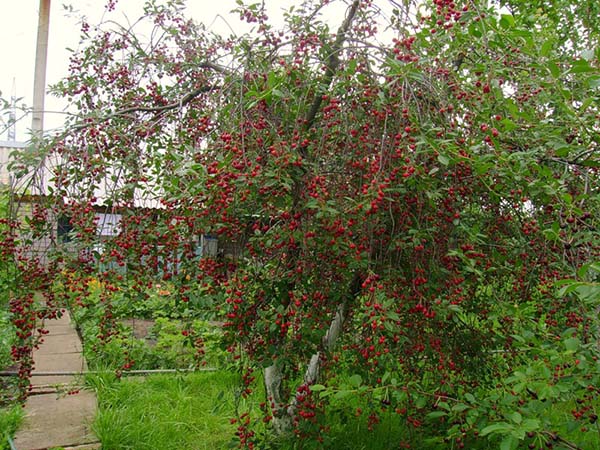
Do not plant cherries in lowlands and even more so wetlands.
In other words, at the landing site moisture should not stagnate in the springwhen the snow melts. Otherwise, the plant will simply underpin the root collar, and it will die.
By the way! Stone fruits (apricots, peaches, cherries) are crops with relatively "weak" root collars (in comparison with seed crops, the same apple trees), therefore, in the zone of risky farming, they are advised to be planted on elevations (mounds).
The occurrence of groundwater in the site intended for planting should be at a level of 1.5 m from the ground surface.
If the groundwater is close, then you have no choice but to make an artificial embankment and plant a seedling on it.
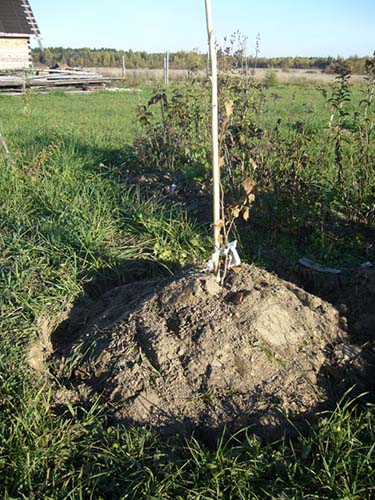
Important! Of course, cherries should not be planted near large spreading trees (especially nuts), as this will negatively affect their growth and productivity (if the seedling can grow and bear fruit normally at all).
The need for pollination
Note! Cherries require cross-pollination, in other words, you need to plant next to like at least 2, and preferably 3 different varieties (the same varieties are not suitable for these purposes), and it is obligatory one flowering period.
Is a neighbor's cherry suitable for pollination? Yes, it will do.
At what distance to plant
Distinguish bush and tree cherries... Their main differences are the height and beginning of fruiting:
- bushy ones grow up to 2-4 m and enter fruiting 3-4 years after planting;
- tree-like - up to 5-6 m, and begin to bear fruit for 4-6 years.
Usually, more popular exactly tree cherries, therefore, they will be discussed below.
So, tree cherries are recommended to be planted according to the scheme - 4 by 3, i.e. distance between rows is 4 meters, between seedlings in a row - 3 meters. Accordingly, bushy ones can be planted about 1.5-2 times closer.
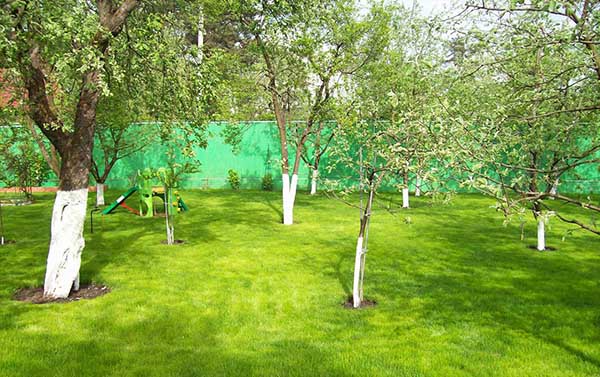
Remember! The closer you plant trees, the more difficult it will be for you to control their crown in the future, in other words, you will need regular and mandatory pruning, including summer pruning.
Soil requirements and preparation of the planting pit
Loamy (loam) and sandy loam soil, as well as light black soil, are perfect for growing cherries.
The soil should be sufficiently light, loose (it is good to let water and air to the roots) and have neutral acidity.
All stone fruits love non-acidic soils and will thrive better in alkaline soils (7.5 pH) than even relatively acidic soils (5.5 pH).
Of course, less successful for planting cherries (and almost all fruit trees) is sandy and clayey soil... In this case, you will definitely need to do good drainage, and then most likely the culture will be able to take root, grow and bear fruit relatively successfully, even under such not very favorable conditions.
Important! When planting a seedling in excessively sandy soil, add a little clay and a lot of compost to it, and sand in clayey soil, this will help balance the mechanical composition of the soil.
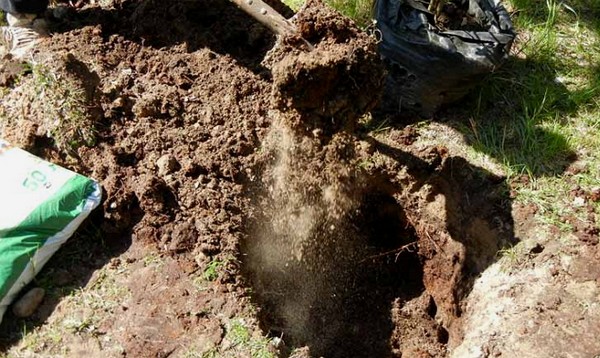
Advice! In a cold and harsh climate, as well as if the earth is clayey, or the site is very waterlogged and the groundwater lies very close, then cherries (like any other fruit trees) are recommended to be planted on gentle hills ("According to Zhelezov").
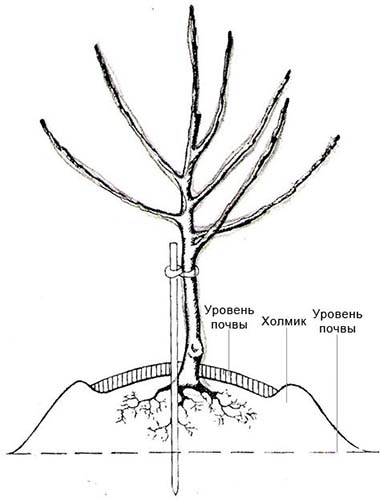
Planting pit dimensions
A planting pit for spring planting of cherries should be prepared in advance. It is best to do this in the fall or at least 1-2 weeks before planting the seedling. During this time, the soil will just have time to settle to the desired level.
Important! When digging a planting hole, the top layer of soil is thrown aside for further use.
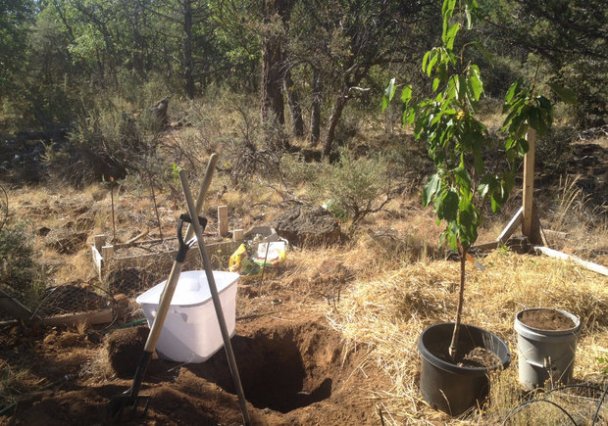
Planting pit width and depth for cherries should be within 50-80 cm (as a rule, on average, they dig a hole of 60 by 60 cm). Moreover, the walls of the recess should not taper towards the bottom, so they should be made vertical.
And here is a planting hole for a seedling closed root do just 2-3 times larger than the container itself.
If necessary, it is immediately laid on the bottom drainage layer 5-15 cm from broken bricks or small stones (it is optimal to use lime or chalk crushed stone, in which there is a lot of calcium and which deoxidizes the soil = lowers its acidity), and then the prepared nutrient mixture is poured.
Important! If you have to plant in clay soil, then, in addition to the obligatory drainage layer, you also need to dig the deepest hole possible.
How to fill the planting hole (fertilizer)
So that the cherry can easily adapt in a new place and strengthen for further growth, when planting, it is recommended to fill the planting hole with a nutrient substrate, in other words, add the whole complex of macro- and partly microelements.
For this, the planting pit is filled with a specially prepared soil mixture (which is thoroughly mixed to a uniform consistency).
So, you will need the following components (mineral and organic fertilizers):
- riding fertile soil (upper 20-30 cm), which you removed when digging a hole;
Part of the top fertile layer should be left for further filling of the seedling.
- a bucket (8-9 kg) of good humus or compost;
a bucket (8-9 kg) of non-acidic peat (either at will, or in case you have sandy soil);
a bucket (8-9 kg) of sand (if you have very clay soil);
- 1-2 cups (200-500 grams) superphosphate or 400-600 grams of bone meal (organic analogue of phosphorus fertilizer);
- half or 1 cup of potassium sulfate (100-200 grams) or 2-4 cups (200-400 grams) wood ash (organic analogue of potash fertilizer).
Or, instead of superphosphate and potassium sulfate, just use 300-400 grams of diammophos.
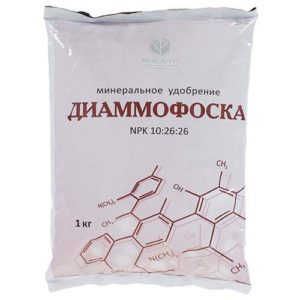
Worth knowing! When planting a tree (especially in autumn), it is not necessary to specially add nitrogen fertilizers (another thing if it is a complex fertilizer), since they stimulate the growth of the aboveground part to the detriment of the development of the root system (especially when planting in the northern regions).
Important! However, some gardeners do not recommend laying mineral fertilizers in the planting pit, but applying them in the future as top dressing.
After filling the pit with a nutrient substrate in its middle, it is necessary drive in a wooden peg, which will further serve as a support for a young seedling.
Direct planting of a seedling
Brief step-by-step instructions for the autumn planting of cherry seedlings in open ground:
- Fill the planting hole with fertile soil in advance, leaving a depression in the size of the seedling root system.
- If you are planting a seedling with an open root system (OCS), then you need to pour a small mound in the center of the planting hole, if in a container (ZKS), then the surface should be flat (without any mounds).
- Drive in a wooden support or peg (if you have not done so beforehand).
- Place the seedling in the center of the mound and spread the roots down along its sides (the roots should never bend and stick up!).
Important! If you have a seedling that was grafted with an eye (budding), then the place of budding (eye = new shoot that has grown from grafting) should preferably be facing north, and the place of cut - south.
- Cover with a fertile soil mixture (top layer + humus or compost), periodically shaking the seedling to eliminate voids between the roots.
Do not confuse the root collar (the place of origin of the first root from the trunk) with vaccination, which is higher and should be located 3-5 cm (you can simply attach 2-3 fingers) above the soil surface. After the tree settles in loose soil, the root collar will in any case take its normal position.
Attention! But if you deeply deepen the root collar, then the tree will grow poorly and gradually die (because the root collar will vytryut). On the contrary, if you plant it too high, the roots of the seedling will be exposed and may simply freeze in winter or dry out in summer.
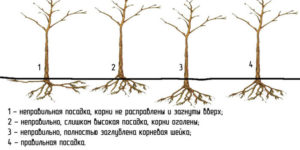
- Compact (tamp) the soil, starting from the edges at the base of the seedling (you can use your foot), so that no air layers remain between the roots.
- Next, you need to make a hole (roller) along the diameter (perimeter) of the trunk circle 5-10 cm high.
- Spill abundantly with water, pouring out at least 2-3 buckets (pour out gradually - wait for it to be absorbed and add more).
Interesting! There is an old proverb: "Put it in the mud - you will be a prince." Therefore, in general, you can shed a hole before planting to plant the seedling directly into the mud.
- Tie the seedling to the prepared support with a soft twine and secure in the correct position.
- Level the roller, loosen the soil in the trunk circle and mulch it sawdust, peat, humus or compost.
Worth knowing! Mulch should not be laid close to the stem of the seedling, as this can cause the bark to undermine.
Video: planting cherries in the fall
Further care for cherries after autumn planting
Immediately after planting is generally recommended prune a seedlingto level the root system with the aboveground part (this is done for a kind of "resuscitation" of the seedling after planting, since any planting and transplanting is an injury and stress for the plant).
However! If you have a seedling with a closed root system, i.e. sold in a pot, this procedure can certainly be omitted. The initial pruning (beginning of shaping) is generally best done in the spring.
Of course, the main condition for the successful rooting of cherries is a sufficient amount of moisture in the soil. If autumn will be warm and not very rich in precipitation, then you will need to exercise weekly watering, pouring out 2-3 buckets of water. And after each watering, if you have not mulched the trunk circle, it is very desirable to slightly loosen the soil at the baseto improve oxygen access to the roots.
Also you need to be sure to correctly prepare cherries for winter, especially protect young bark from rodents.
In general, that's all. What is good about the autumn planting is that the care is minimal.
Let's hope that your cherry tree will survive the fall planting well and quickly take root in a new place!
Video: master class on planting cherries in the fall

